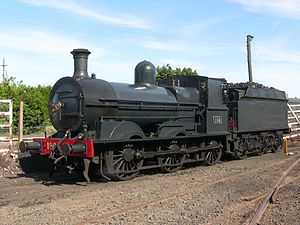GS&WR Class 101
| Great Southern & Western Railway Class 101 | |
|---|---|
|
Preserved No.186 in steam at Whitehead, County Antrim, in 2010. | |
| Type and origin | |
| Power type | Steam |
| Designer | Alexander McDonnell |
| Builder |
Inchicore Works (91), Beyer, Peacock & Co. (12), Sharp, Stewart & Co. (8) |
| Serial number |
BP: 747–750, 780–783, 1251–1252, 2029–2030 SS: , 2155–2158, 2310–2311, 2837–2838 |
| Build date | 1866–1903 |
| Total produced | 111 |
| Specifications | |
| Configuration | 0-6-0 |
| UIC classification | C |
| Gauge | 5 ft 3 in (1,600 mm) |
| Axle load | 13 long tons 0 cwt (29,100 lb or 13.2 t) |
| Locomotive weight | 37 long tons 13 cwt (84,300 lb or 38.3 t) |
| Cylinders | Two, inside |
| Cylinder size | 18 in × 24 in (457 mm × 610 mm) |
| Performance figures | |
| Tractive effort | 17,170 lbf (76.4 kN) |
| Career | |
| Operator(s) | GS&WR → GSR → CIÉ |
| Class |
GS&WR: 101 GSR: 101/J15 |
| Withdrawn | 1886–1963 |
| Preserved | 184 & 186 |
| Current owner | RPSI |
| Disposition | Two preserved, remainder scrapped |
The Great Southern and Western Railway Class 101, classified as Class 101 or Class J15 by the Great Southern Railways, was a class of 0-6-0 steam locomotives designed for working goods traffic although they did, and were quite capable of, working branch or even main line passenger trains.
The 101s were by far the most numerous class of locomotive (diesel or steam) ever to run in Ireland with 111 being built between 1866 and 1903 with only minor modifications between batches. The great majority were built by the GS&WR at Inchicore Works, though the construction of some examples was contracted out to Beyer, Peacock and Company (12) and Sharp, Stewart and Company (8), both famous Manchester based locomotive building firms.
The 101s survived long after many more modern steam locomotives were scrapped with nearly half their number still in traffic when the Córas Iompair Éireann completed dieselisation at the end of 1962.
Specification
The RPSI has an example, No.186
- Class: J15
- Wheels: 0-6-0
- Company: Great Southern & Western Railway
- Designer: Alexander McDonnell
- Builder: Sharp, Stewart and Company, Atlas Works, Manchester (Works No. 2838)
- Dates: Built:1879; Withdrawn:1964
- Boiler: Z
- Boiler diameter: 5 ft 1 3⁄4 in (1.57 m)
- Cylinders: 18 in × 24 in (457 mm × 610 mm)
- Tractive effort: 17,170 lbf (76.4 kN)
- Total weight: 37.65 long tons (38.25 t)
- Axle load: 13.00 long tons (13.21 t)
Preservation
Two have been preserved by the Railway Preservation Society of Ireland making them the most numerous class of preserved Irish steam locomotives.
- No. 186, a Sharp, Stewart engine, has a superheated larger boiler with a Belpaire firebox and tender no. 375, a larger 3,345 imperial gallons (15,210 l; 4,017 US gal) tender.[1]
- No. 184 has a smaller saturated boiler with round-topped firebox, and was paired with tender no. 156,[1] an 1,864 imperial gallons (8,470 l; 2,239 US gal) outside-sprung tender. To give a larger water capacity, No. 184 has been paired with the larger tender when used on the Irish railway network.
As built the locomotives would have carried the lined dark olive green livery of the Great Southern & Western Railway until around the start of the 20th Century. After that, they were black with red lining until the late 1910s, when they were painted all over unlined grey. This dull but all-encompassing livery included motion, wheels, inside frames, cabs, smoke boxes and chimneys. The only relieving feature was the red buffer beam. Standard cast number plates were also painted over grey, with rim and numerals picked out in cream or very pale grey, or occasionally not at all. This livery persisted post-1925 into Great Southern Railways days, and was extended to locomotives of other constituent companies after the GSR amalgamation of that date. On the formation of CIE in 1945, the only change was that the cast number plates were gradually removed and pale yellow numerals were painted on instead. In addition, most tenders received a lined pale green "flying snail" logo. Both locomotives are out of service awaiting overhauls, with No. 186 last operating in late 2013.
While CIE repainted a few locomotives in green or black, all of the J15 class remained grey until withdrawal.
In film
The preserved locomotives have appeared in various films. Most recently, No. 186 appears in the 2006 film, The Wind That Shakes the Barley. Both 184 and 186 appear in the 1979 film, The First Great Train Robbery.[2]
Model
The Class 101 is available as a 00 gauge etched-brass kit from Studio Scale Models. It includes transfers, brass etches and cast white metal parts.
See also
- Coaching stock of Ireland
- Multiple units of Ireland
- Rail transport in Ireland
- Steam locomotives of Ireland
References
- ↑ 1.0 1.1 Clements & McMahon 2008, p. 295
- ↑ "Film Contracts". RPSI. Retrieved 2009-01-14.
- Clements, Jeremy & McMahon, Michael (2008). Locomotives of the GSR. Newtownards: Colourpoint Books. pp. 76–83, 281, 283, 295. ISBN 978-1-906578-26-8.
External links
| Wikimedia Commons has media related to GS&WR Class J15. |
| ||||||||||||||||||||||||||||||||||||||||||||||||||
